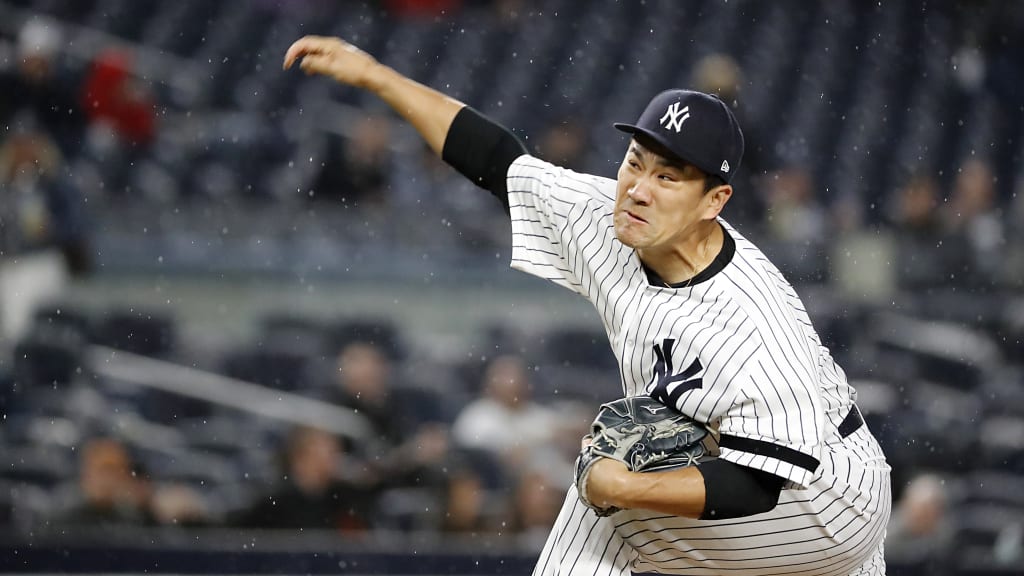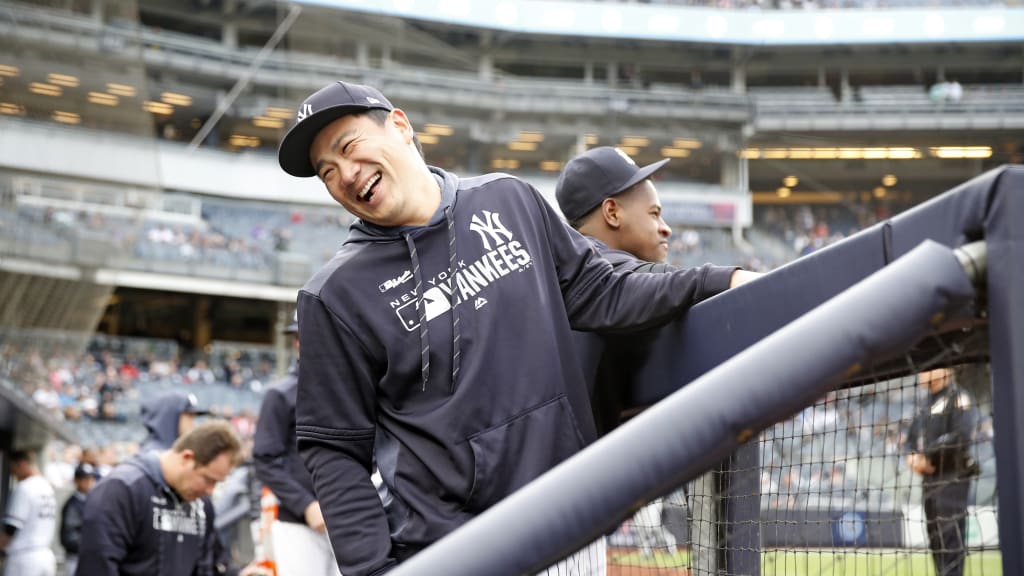
A pitcher’s best weapon is not supposed to land 431 feet away, clearing the fence in straightaway center field. It’s not supposed to exit a hitter’s bat at 111.3 miles per hour, mimicking a speeding bullet. It’s not supposed to hang lifelessly in the middle of the plate, begging to be barreled.
But that’s the fate that befell Masahiro Tanaka’s splitter on May 28. With a 1-0 count, two on and nobody out in the top of the first, the right-hander threw his signature pitch to left-handed batter Eric Hosmer. Tanaka’s splitter never took a dive, however, and the Padres’ first baseman drilled it into the netting above Monument Park. Tanaka settled down after that, allowing just one more earned run over six innings, but the Yankees could never quite climb out of that first-inning hole, eventually losing, 5-4.
It was not the first time Tanaka’s splitter betrayed him this season. Clearly annoyed after the loss, which dropped his record to 3-4, he openly admitted that he had been “having trouble executing that pitch.”
A few days later, his aggravation not completely subsided, Tanaka was able to put his struggles in perspective. “Obviously there’s some frustration there, but I’ve gone through these types of stretches throughout my career. Sometimes you have certain pitches, sometimes you don’t,” he said. “I understand everyone is really concerned about the splitter for now, but for me, I’m confident that I’m able to overcome this type of situation.”
Really, it was just one mistake that hurt Tanaka that night. His season has been peppered with similar instances, split seconds -- no pun intended -- when the feel for his favorite grip has evaded him, but that has hardly stopped him from pitching effectively. The 30-year-old began the season with a 3.23 ERA, 1.09 WHIP and a well-above average 139 ERA+ through his first 15 starts. For a while, Tanaka was the Major League leader in Command+, a new-age metric that measures a pitcher’s ability to hit his spots. Even when he has had to grind, Tanaka has helped carry a rotation that has been shorthanded since the campaign commenced.
That splitter could always be better, though. Tanaka could always be better.
He expects himself to be.
***
After five-and-a-half professional seasons in the United States and another seven in Japan before that, Tanaka has earned a reputation as a perfectionist. Ask anyone in the Yankees locker room about him and they will immediately bring up the long hours he puts in before, after and during his moments on the mound. That’s why manager Aaron Boone called him “a master at his craft” the night of the Padres game, expressing complete confidence that his pitcher, rarely satisfied, would work tirelessly to find the pitch that has been eluding him. It’s why Brett Gardner described his teammate as “a heckuva competitor” and someone who “takes his job very, very, very, very seriously.”
“He’s got one of the best work ethics I’ve ever seen,” Austin Romine adds. “His preparedness is unbelievable. He knows exactly how he’s trying to pitch guys. He watches video like no other. I’ve never seen anybody so focused on being good.”
That focus, that determination, was fostered at a young age amid a youth baseball culture that drastically differs from America’s. Tanaka first burst onto the scene at Komazawa University Tomakomai High School, a two-hour flight from his hometown of Itami, Japan. There, he cemented his name in Japanese baseball lore at Summer Koshien, the annual nationwide high school championship tournament famous for its frenzied crowds -- and for pitch counts that still make stateside evaluators cringe.
As a junior in 2005, Tanaka threw a 93 mph pitch, the fastest by a non-senior in Koshien history. The unprecedented radar reading was the last of the tournament; Tanaka was on the bump as his school sealed its second straight national championship.
That performance was nothing compared to the sequel, though. Tanaka delivered a master class in grit as a senior, throwing 742 pitches over 522⁄3 innings in six Koshien appearances. Pitching through intestinal inflammation, he entered the 2006 championship game in the third inning, twirling 12 2⁄3 frames of one-run relief before the game ended in a 1-1 tie after 15 innings. When the contest was replayed the next day, there was Tanaka and his adolescent rubber arm coming to the rescue midway through the first inning. Throwing without even 24 hours’ rest, Tanaka never left the game. He allowed three runs, however, and Tomakomai lost, 4-3.
Despite falling short of a three-peat, Tanaka’s performance was a case study in fortitude, as well as the strains that are placed on young Japanese pitchers. In retrospect, the gutsy display defines the type of pitcher Tanaka still is.
“I didn’t think anything of it,” he says now. “I wanted to go out there, and I wanted to pitch. I was in that culture, so that was the norm for me. I didn’t know anything else.”
***

Thirteen years later, Tanaka, does know something else. He had already accumulated a lifetime’s worth of experience by the time he joined the Yankees via the posting system, signing a seven-year, $155 million contract prior to the 2014 season. Tanaka’s resume up to that point included breaking Daisuke Matsuzaka’s Japanese high school strikeout record, pitching in the Beijing Olympics and two World Baseball Classics, and winning the Japan Series -- Nippon Professional Baseball’s equivalent of the World Series -- with the Tohoku Rakuten Golden Eagles, the team that drafted him after high school.
It wasn’t until Tanaka logged the greatest year in NPB history -- a 24-0 regular season with a 1.27 ERA capped by the Japan Series victory that featured a complete game in Game 6 and a save in Game 7 -- that he came to New York. Years of thriving on Japan’s biggest stages assured the Yankees they were getting a gamer who could handle the bright lights of Broadway, a litmus test that has held true in the half-decade since Tanaka’s arrival.
Tanaka has been a steady force since his debut in pinstripes, going 69-39 with a 3.56 ERA and a 1.10 WHIP through June 21 of this season. He is one of two pitchers in Yankees history -- the other being Andy Pettitte -- to win at least 12 games in each of his first five seasons, and he is the only Japan native to record at least 10 wins in each of his first five Major League seasons. Like he did in his home country, Tanaka has flourished in the postseason time and again, registering a 1.50 ERA in five October starts.
Statistically, the transition from NPB to MLB has been seamless for Tanaka. But moving to a foreign country did present challenges that he couldn’t pitch himself through. Everything from getting around to finding a place to eat to communicating with teammates was a challenge at first. The culture is different. The language is different. Everything is different.
That includes a baseball subculture that obsesses over pitch counts, innings, stress and leverage. Tanaka was expected to be a limitless workhorse before he was old enough to drive in Japan; his high school coaches would scoff at the way Major League teams monitor their pitchers’ every move. Off the field, Tanaka has had to overcome a language barrier in a diverse clubhouse. Interviews -- excluding those with the Japanese press contingent that follows him around -- require Major League interpreter Shingo Horie by his side. Palling around with peers came with inherent struggles.
A lot of that has changed over the years, though. While Tanaka still uses Horie as an intermediary with the media -- and still is not sold on pitch counts, either -- the now-veteran has picked up enough English that he can easily interact with teammates. As a result, more of his personality has begun to show over the last couple of years. Tanaka admits that he has come out of his shell more, slowly allowing the demonstrative, exuberant pitcher he was back home to re-emerge.
“It’s only natural that he’s maybe gotten a little more comfortable,” says Gardner, one of the few Yankees who has been around for Tanaka’s entire Major League tenure. “It’s easier for him to communicate with the guys. I’m sure that’s a huge transition, coming over here. It takes quite a while to get adjusted.”
While fans and reporters may still perceive Tanaka as quiet and reserved, his teammates know better.
“He’s actually a pretty funny guy off the field when you can get to talk to him,” Romine says. “That language barrier is tough at times. I think he’s getting better with it, and I think he’s opening up a little more. Like any other baseball team, guys mess with the guys. He’ll give it back sometimes. He’s just very calm and level, but at times he’s hilarious.”
***
While Tanaka’s outward persona has evolved over the years, his core mentality has remained narrowly focused. “You’re always aiming to become a better pitcher,” he says. That unflinching desire can result in near-perfect performances, such as the two-hit, 10-strikeout gem he produced in a 3-0 shutout of Tampa Bay on June 17. It was no coincidence that his splitter returned to form that night.
But what happens when a perfectionist can’t match his own lofty expectations?
“He’s very surgical with everything he does,” Romine says. “He expects a certain level of perfection and if he doesn’t get it, he gets a little frustrated. What you don’t know is that he’s a pretty big bulldog out there when he’s on the mound. He expects a lot of himself. You hear him yelling sometimes and really pumping himself up, and it’s fun.”
Given the high bar Tanaka sets for himself, it’s easy to imagine him obsessing over poor performances. He’s actually gotten better at putting such outings behind him, though, moving on from the emotions that accompany a rough night while focusing between starts on what he needs to improve. “You always kind of have to flip the page,” he explains. “You look at the game and assess the game and you tell yourself, ‘OK, today’s game turned out this way, so you kind of have to live with that.’ That’s kind of the conversation I have with myself.”
Those internal discussions have occurred frequently this season as Tanaka tries to regain his splitter’s consistency. But, he says, “You’re not going to burn yourself down because you don’t have certain pitches.”
The reality is that perfection is not possible every time Tanaka -- or any pitcher, for that matter -- takes the mound. There will be more days when that splitter refuses to plunge, when his fastball lacks life, when his slider hangs, when his command misses the mark. Those are the facts of pitching in the big leagues. He knows this, even if he doesn’t like it. It’s just another element that requires adaptation.
“You don’t necessarily have your best stuff every single day,” Tanaka says. “It’s more ups and downs going through the season. The days that you have your best stuff are minimal. You don’t have that very often during the season. The best pitchers in this league are the ones who are consistent enough to go the distance without having their best stuff.”
It’s an accurate observation from the veteran pitcher, one that sounds awfully self-descriptive.
